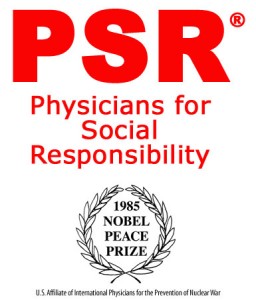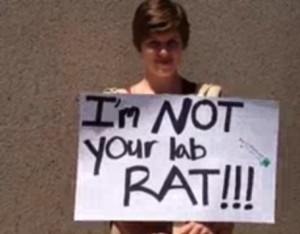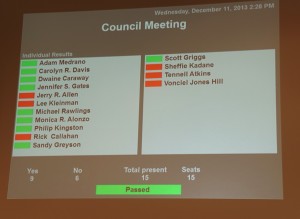“We don’t really know, 8,000 feet below, where the waste goes”
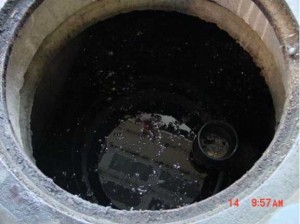 That's Texas Supreme Court Justice Paul Green blurting out an unfortunate truth even as he was trying to defend an injection well that's being sued for trespassing into groundwater under an adjacent rice farm in Liberty County near the Texas gulf coast.
That's Texas Supreme Court Justice Paul Green blurting out an unfortunate truth even as he was trying to defend an injection well that's being sued for trespassing into groundwater under an adjacent rice farm in Liberty County near the Texas gulf coast.
The Texas Tribune's Jim Malewitz has the scoop on a so far mostly over-loooked case that could set some important precedents about land rights and underground contamination. How do we know? Because the oil and gas industry told Maelwitz:
In 1997, Environmental Processing Services finished drilling an injection well about 400 feet from FPL Farming’s land, which the farm contested early on. Since then, the company has injected more than 100 million gallons of wastewater, gradually expanding the well's underground footprint.
The well in question is labeled Class I and used for nonhazardous industrial waste. It is not one of the 50,000 Class II wells that drillers typically use. But lower-court opinions have drawn no distinction between the wells. That has stirred concerns among oil and gas producers that a ruling in the farm’s favor would complicate efforts to dispose of drilling waste, thereby stalling production.
“Because the ability to produce oil and gas is inextricably tied to the availability of injection wells,” the Texas Oil and Gas Association says in a brief, “a new common law cause of action that threatens operation of injection wells likely threatens oil and gas production."
As Malewitz points out, the case raises the questions of "just how far below the earth’s surface do property lines extend? And can someone trespass on another’s property — more than a mile underground?"
Since it's close to the coast, the farm's groundwater is too salty to drink now but the farm's lawyers argue that desalinization technology could render the water useful. They say regardless of its salinity, it's a resource and a piece of private property that's being poisoned by the well's waste stream that includes the flammable liquid acetone.
Now you may think the waste well operators, "Environmental Processing Services," would deny any contamination of the farm's water as a first line of defense. But as it turns out everyone in industry and the regulatory agencies believes that after you've pumped 100 million gallons of industrial waste down a hole 800 feet deep, it will tend to "migrate" outside the fence line of the well itself. So what kind of arguments are EPS's lawyers that the Texas Supreme Court is finding so persuasive?
1) Our waste may be migrating, but since we can't go down there and check, you really can't conclusively prove that it's under the farm…yet. All you have is an industry-government model that everybody uses that says it has.
2) The water is already polluted with too much salt, so there's no way you can pollute already polluted water. So there.
3) Even if it is polluted by our waste, maybe that same desalinization technology the farm wants to use to make the water useable will also be able to filter our industrial waste out if it.
Of course, these equivocating arguments in court by lawyers are a far, far cry from the air-tight assurances Texans get from the industry spokespeople or slavishly pro-industry elected officials, who GUAR-AN-TEE that no fracking waste injection well could ever contaminate groundwater.
Really. You should go read the article. The lawyers are making lots of money on this one. No timeline for a ruling.
Physicians for Social Responsibility Talk This Thursday Night
DFW has a lot of things, but one thing we do not have is a group of medical professionals who speak out for environmental health when it's threatened by pollution or other human-made disasters. Nationally, the group Physicians for Social Responsibility (PRS) has filled this role for over 50 years now. Founded in 1961 to make the medical case against a "winnable" nuclear war, the organization has morphed into a strong voice for clean air and water from a public health point of view.
Despite being a national center of medical research and care, DFW doesn't have a local chapter of PSR. But this Thursday, Chris Masey, the Austin-based Texas Director of the group will be in Dallas to talk about their connection to current energy and environmental fights, including the one against aging East Texas coal plants that were the subject of a Dallas County Medical Society petition to the Texas Commission on Environmental Quality.
His visit is sponsored by Dallas Interfaith Power and Light. Its scheduled for this Thursday beginning at 7 at the White Rock Methodist Church on Oldgate Lane. Here's what their blurb says about the talk:
Chris will speak about air quality as a crucial key to human health including fossil fuels background and information, specific toxic emissions, air as a carcinogen, climate disruption, and the shifting patterns of infectious diseases. Chris’s lecture will also include information about Texas PSR, and ongoing advocacy efforts to phase out and close coal-fired power plants and to advocate for stricter carbon emission standards.
More about our speakers: Chris Masey, MBA, is a eighteen-year environmental professional who has worked on a diverse set of projects throughout Texas focusing on public health, conservation, land stewardship, alternative energy sources, recycling, and environmental and solid waste planning. During the last two years, Chris has proudly helped guide Texas PSR (formerly Austin PSR) to become the largest environmental advocacy group led by healthcare professionals in Texas! Chris’ dedication to environmental sustainability is grounded in his love of Texas and the desire for his family to continue to enjoy clean air, clear water, and wide-open spaces.
If you're a medical professional who's interested in helping out citizens in need, or you know someone who fits thst description, please consider attending this Thursday's meeting. There's really no excuse for a metropolitan area the size of DFW not to have a cadre of concerned doctors and nurses who can speak put against fracking close to homes or burning plastic in cement kilns, or just confirm for some of our more aggressively ignorant elected officials that indeed, smog and lead are bad for people. With any luck, perhaps Chris Masey's appearance here this week can begin a conversation that leads to such an effort. It is way overdue. See you there.
“Unacceptable Levels” Screening January 30th Reveals How Your Body is Ground Zero in the Chemical Wars
New Film Screening
One Night Only
"Unacceptable Levels"
One man and his camera traveled extensively to find and interview top minds in the fields of science, advocacy, and law. He weaves their testimonies into a compelling narrative of how the chemical revolution brought us to where we are, and of where, if we’re not vigilant, it may take us.
Thursday, January 30 7:30PM
at AMC Valley View 16 in Dallas
$11.00
(Only 100 tickets left as of Monday)
It doesn't take the average citizen very long to figure out that it's not only the chemicals being released from the drilling pad, or cement plant, or lead smelter they're fighting against that's harming them, but also the way those chemicals are allowed to be dispersed into the public commons and our bodies by government regulators.
Every month generates a new study confirming how levels of a pollutant previously thought to be "safe" actually turn out to be harmful. Or that exposures to multiple chemicals can cause cumulative health impacts not currently assessed. Or that even if one generation escapes harm from a dangerous exposure, as many as three of four future generations of descendants are still at risk from being harmed by that very same exposure. The more we study contamination, the more extensive and complex it is.
Meanwhile, government regulators are stuck in a simplistic 19th Century, "Arsenic and Old Lace" risk assessment view of the world that's completely underestimating the harm of 80,000 synthetic chemicals on the marketplace. They're in our food. They're in our water. They're in our air. They're in our sippie cups and backpacks and jewelry. Only a handful – less than 200 – have been studied extensively. We're all lab rats in a huge, unprecedented experiment on human health. Your body is now ground zero in this experiment, whether you like it or not.
Why are there higher rates of child asthma, autism, food allergies, immune system problems? Adult onset asthma is increasing, soaring lung cancer rates among non-smokers and insulin resistance-related maladies? Science tells us all of these health problems, and more, can be caused by an increasing body burden of higher and higher doses of involuntary chemical exposures.
There is no better or faster way to get schooled on this contradiction between the science and regulation of chemical exposure than a new 90-minute film coming to Dallas on January 30th called "Unacceptable Levels."
First, it assumes the Everyman viewpoint of Ed Brown the filmmaker. He's not a professional environmentalist or propagandist. He's a dad that works in a restaurant that's wondering what in the food and water he and his family are ingesting. It's his curiosity about the chemicals he's surrounded by, just as it is with most citizens being shat on, that fuels the film's narrative.
Brown hits the road and talks to some of the leading environmental health researchers and advocates, including Dr. Richard Clapp, Professor of Environmental Health, Boston University and Biologist Dr. Tyrone Hayes at The University of California, Berkeley, Randy Hayes of Rainforest Action Network, and Jeff Hollender, the former CEO of Seventh Generation. You never get the feeling you're being preached to or given a scolding. Ed Brown is as surprised as anyone else at what he's finding out as he makes each of his stops. (We've put in a request to interview Brown. Stay tuned)
Second, the film breaks the information down into bite-size pieces that are digestible even if you start out knowing nothing about environmental health. This is meant to be a primer for the average citizen, so bring your skeptical Tea Party uncle or aunt and see, if by the end of the film, they still think the EPA is "over-regulating" industry.
Finally, even though it doesn't address air contamination issues that Downwinders works on, the facts of how "small stuff adds up" and affects human health when it comes to industrial poisons is exactly the same no matter how you get exposed. It's the same rotten out-of-date system that's allowing the exposure. There's no better one-stop explanation of how that binary "safe/not safe" system stinks than this film. It's a great case for regulatory reform.
Downwinders at Risk has a long history of challenging that system. In 1996, we published "Sacrificing Science for Convenience," by the late Dr. Marvin Legator of the University of Texas at Galveston, the first journal-published and peer-reviewed critique of the way the State of Texas assessed toxic exposures. It paved the way for an historic Houston Chronicle series and even produced some reform of procedures. We've continually challenged the "safe" levels of ozone pollution allowed by EPA despite their own scientists telling them otherwise, as well as "acceptable" levels of toxins from cement kilns and gas wells. Currently, we're fighting over what are "safe' levels of lead to leave in Frisco from the Exide smelter.
If you want to know a bit more about the kind of issues talked about in the film and how they relate for the January 30th screening of "Unacceptable Levels," please see these past posts:
The Dose No Longer Makes the Poison, But We Regulate It As if It Does
Another Study Reveals Why Our System of “Safe Levels” is a Tragic Mirage
Dallas-based Gulf War Illness Study Points to Low Level Chemical Exposure; DMN Ignores
Was Azle the Barnett Shale’s “Walter Cronkite Moment?”
 When Walter Cronkite announced that America was losing the war in Vietnam, LBJ knew he'd lost Middle-America.
When Walter Cronkite announced that America was losing the war in Vietnam, LBJ knew he'd lost Middle-America.
When the gas industry is losing the editorial board of the Fort Worth Star-Telegram, is it a sign it's losing the PR war in the Barnett Shale?
While Sunday's editorial in the Star-Telegram, titled "Texas Railroad Commission can’t just tippy-toe around quakes" falls far short of a wholesale condemnation of urban injection well operations, it does castigate the Railroad Commission for being promoters of fracking while also being assigned to regulate it on behalf of the public good, and faults it for failing to provide any new facts to the debate at its disastrous public meeting last week in Azle.
Is the three-member commission doing anything to separate facts from speculation and theories?
“In addition to taking the residents’ comments into serious consideration, Commissioner Porter has been in communication with the state geologist in regards to a potential study by the Bureau of Economic Geology,” Porter’s news release said. “Railroad Commission staff is also participating in a work group formed by the Environmental Protection Agency, which includes representatives from the United States Geological Survey and other state regulatory agencies.”
There’s “serious consideration,” a “potential study” and a “work group.” Sounds like tippy-toeing.
In fact, there is a considerable amount of science linking disposal wells, which push millions of gallons of drilling waste into rock formations deep under ground, with “induced” earthquakes.
A report posted in July described one study by USGS scientists. The results were also published in the journal Science.
The rate of quakes increased to about 100 a year in the central and eastern U.S. in the three-year period from 2010 through 2012, up from an average 21 a year from 1967-2000, the study showed. The increase coincided with a rapid increase in oil and gas drilling using hydraulic fracturing, which leaves large amounts of waste water for disposal.
In many ways, the developments in Azle last week represent a bigger threat to the industry than residents' December victory in Dallas over a more protective gas drilling ordinance. It's deep in the heart of the urban Shale instead of being at its edge. It's a spontaneous grassroots revolt led by people who probably voted for Ted Cruz instead of Paul Sadler in 2012. Its participants have lived with fracking for almost a decade now instead of fighting off an invasion as in Dallas. These are folks who are more likely to carrying a concealed weapon than a Sierra Club membership.
It's also true that both industry and government have been caught off-guard by the issue of injection-well earthquakes and are unable to bat down the arguments the way they can with harms that take more time, and have more subtle causal links, like cancer. Empirical evidence makes the case pretty plain, as the Star-Telegram editorial admits. Denials by industry in the midst of earthquake "swarms" centered on injection well locations seem like the environmental equivalent of a reassuring "Baghdad Bob" show while the bombs are falling in the background.
Do the circumstances taking place in the western part of the Metromess represent a new front on the fracking fight in North Texas, or just a momentary rise in tensions that will be gone by the Spring? A lot depends on whether the pace of earthquakes that gave rise to the Azle meeting keep occurring. Thirty of them have been recorded since November alone and if they keep showing up at that rate, there'll be little need of community organizing meetings to get people motivated to do something. The question is what that something is.
A prohibition on injection wells within Standard Metropolitan Areas? Within certain population densities? Within proximity of water wells and infrastructure? A moratorium on any new wells anywhere? Is there and answer that can help the people in Azle and maybe others in the Shale at the same time?
Time will tell whether last week's meeting is a real turning point for facts on the ground, but it's already clear that it marked a milestone in terms of perception. And as we're often fond of saying here at Downwinders, perception is everything.
Follow-Up Study Confirms Lower Birth Weight Babies Around Fracking Sites
 A 2012 study by a Cornell graduate student Elaine Hill that found a 25% increase in low-birth weight babies within 1.5 miles (7920 feet) of a gas fracking sites in Pennsylvania got a boost from a follow-up study previewed over this last weekend at a conference in Philadelphia.
A 2012 study by a Cornell graduate student Elaine Hill that found a 25% increase in low-birth weight babies within 1.5 miles (7920 feet) of a gas fracking sites in Pennsylvania got a boost from a follow-up study previewed over this last weekend at a conference in Philadelphia.
Janet Currie of Princeton University, Katherine Meckel of Columbia University, and John Deutch and Michael Greenstone of the Massachusetts Institute of Technology also looked at Pennsylvania birth records and found the risk of low-weight births increased by 50% within 2. 5 kilometers (8125 feet) of a fracking site. That's over 7 times the distance of the recent 1500 foot buffer zone between homes and drilling pads passed by the City of Dallas last month.
This rate was constant for both households with their own water wells and municipal water system users, seemingly ruling out water contamination as a cause. Air, noise and light pollution are now the suspected culprits.
This second study was specifically designed to address critics of Hill's previous work:
"….they built on the work of Elaine Hill, a PhD student at Cornell University who sparked controversy in 2012 with a study showing that infants born near fracked gas wells had more health problems than infants born near sites that had merely been permitted for fracking. One criticism of Hill's study was that fracking activity might change the demography of an area, attracting more mothers who are likely to give birth to infants with health problem.
The new research addresses such concerns by following a constant group of mothers who had children both before and after the onset of fracking, and by controlling for geographical differences in mothers' initial health characteristics. It seeks to achieve the rigor of a controlled experiment by focusing on mothers who, due to their locations and the dates of their pregnancies, were effectively selected at random to be exposed to fracking.
The study is expected to be accepted for publication sometime this Spring after being peer-reviewed.
Merry Xmas and Have a Less Poisonous New Year
Seeing Progress On $84 A Day
 Like What We Just Accomplished in Dallas? Please Help Us Keep Doing Good Work. Donate Before January 1. Thanks.
Like What We Just Accomplished in Dallas? Please Help Us Keep Doing Good Work. Donate Before January 1. Thanks.
"One of the toughest gas-drilling ordinances, not just in the Barnett Shale, but in the nation." That's what the media has been saying about the new Dallas gas drilling ordinance that residents won last Wednesday at City Hall.
Thanks to everyone who ever came out to a Planning Commission or City Council meeting or hearing. Thanks to those who provided a spectrum of heart-felt testimony. Thanks to those who sent e-mails when we asked you to, wrote letters and made phone calls. Thanks for hanging tough with us through the long slog of Trinity East battles, followed by the laborious job of actually writing a new ordinance – all within a system that was rigged against us. Showing up makes a difference.
Do-It-Yourself Democracy is messy and time-consuming. We hope you think the final results were worth it. We do. Combined with the Trinity East permit denials, we think this ordinance was one the most effective counter-strikes against a powerful Barnett Shale Gas Lobby in years. it had the additional advantages of giving local environmentalists political muscle in Dallas politics they haven't had before, and giving hope to others fighting for more protection from gas facilities elsewhere. We've gotten thank-yous and inquires from across the country.
The Dallas gas ordinance is just the latest and best example of the Downwinders at Risk philosophy of using local fights to set national precedents. Stick around, stand your ground, and lead by example. Or as some Greek guy named Archimedes once said, “Give me a place to stand and I will move the world.” What residents accomplished at Dallas City Hall last week moved the world.
We don't have to be beholden to Austin or Washington for "change" to trickle down from those capitals. We can make serious grassroots social change right here in the Belly of the Beast that has a national impact. It doesn't happen by accident, or just because we have a righteous cause. It happens because of years of planning and intense campaigning. Of constantly showing up, doing the research, attending the meetings, making the appointments, getting things done.
While this last Wednesday's win was a group effort, there's no doubt that Downwinders at Risk provided the leadership, the strategy, and the experience to mold the movement in Dallas into an effective policy-making juggernaut that it had not been elsewhere in North Texas. It's not a coincidence that this breakthrough came in Big D. Three years ago Downwinders said we were drawing a line in the Shale in Dallas and fighting back against an industry that thought it had a blank check to do just about anything it wanted. Along with the defeat of the Trinity East permits earlier in the year, we think the new Dallas ordinance delivers on that goal.
Since Downwinders at Risk decided in 2011 to expand its mission to protect the entire DFW airshed from toxic air pollution, all we've done is shut down a outlaw lead smelter, stop a wave of new park and floodplain drilling, and pass one of the most protective gas ordinances in the country. What other group do you know of that could turn on a dime and win on all those local fronts – or has the resources or motivation to do so?
We think we've done a good job of proving the same organizing strategy that cleaned-up the Midlothian cement industry can be applied effectively to other important threats to public health.
That strategy starts with paying at least one full time professional staff person to represent citizen interests in clean air fights and work on their behalf. Industry has armies of consultants and lawyers. Government as well. Citizens come to fights like the Dallas Gas Wars with no such pool of expertise. If your group or cause can't afford to hire a lawyer and other specialists, then you're very much alone. Until you call Downwinders at Risk. And then, for no charge at all, you get hours and hours of relentless effort that may, with some luck, change your life and the world.
We offer this service to all comers on a organizational budget that measures out to about $84 a day.
That amount of money can't buy you much. Larger environmental groups could spend that on copy toner alone. But when Downwinders' spends it, it can buy you 4000 pounds less lead every year in the air you breathe, or a lot fewer gas wells next to your neighborhood.
In 2014, Downwinders at Risk will be 20 years old. We have no idea how we'll change history in the next 12 months, but we do know that we will change it, because we'll keep showing up trying to change it. And persistence is very much part of our success.
We're going to follow-up the Dallas ordinance with the passage of the nation's first local air pollution off-set rule that can plug the loophole the gas industry uses now to escape Clean Air Act requirements to balance their impacts in smoggy areas. We're going to think about whether we can deploy the same coalition model that worked so well in Dallas deeper into the Shale. We're going to keep trying to prevent the City of Frisco from building a permanent toxic waste landfill in the middle of town. We're going to be trying to use a new DFW clean air plan to get new pollution controls for cement plants, coal plants, the gas industry and other large sources.
We're 100% local. Our board all lives here in DFW. Our entire mission is devoted to making air cleaner in DFW. We're completely dependent on local sources of funding. That means people like you. If you don't support us, then we can't pay our staff person to show up. And when he doesn't show up, the system isn't nearly as citizen-friendly.
We think this last year's worth of headlines from the Dallas Gas Wars and the Frisco lead landfill fight is our best case for asking for your tax-deductible donation before the calendar year ends. We need your help to keep making those kind of headlines. We promise to do our part. Please consider a contribution to Downwinders of at least $84 to sponsor a day's worth of DFW clean air organizing. All you have to do is fill out the secure online form by clicking here. We not only really appreciate your support, we can honestly say we can't do our work without it. Thanks.
Coming to A Cement Plant Near You? Burning Fracking Fluid
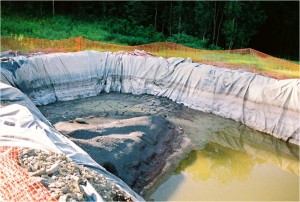 A Canadian LaFarge Cement plant wants to start using fracking fluid to replace fresh water it uses in its manufacturing process.
A Canadian LaFarge Cement plant wants to start using fracking fluid to replace fresh water it uses in its manufacturing process.
The company's Brookfield plant in Nova Scotia is an ancient "wet kiln" that uses approximately 35 million liters of water from a near-by lake to produce cement. Fracking fluid that has been run through a reverse osmosis filtering process would be used as a parital substitute for this fresh water.
According to the local newspaper account, a LaFarge PR spokesman is quoted as saying “It’s safe enough to drink. The contaminants have been removed and the recycled waste water exceeds government guidelines to be released in the environment.”
But funny thing. Despute that assurance of safety, when the company ran a full page ad announcing its plans to use waste water, it forgot to mention that it was waste fracking fluid. Maybe because there's a moratorium on fracking in the Province while a review of its safety and public health impacts are investigated.
Local municipal Council Member Doug MacInnes said he spoke to the LaFarge plant manager about the ad.“He explained to me that it was worded that way so that it wouldn’t get the public upset." According to the LaFarge manager, "I think there is a negative connotation with fracking."
So where is the waste fracking fluid coming from? From two local holding ponds that have been containing the leftovers of three wells way back in 2007 and 2008. About 14 million litres of fresh water was used. When this water was regurgitated by the wells it was poured into the ponds. Many observers believe that although this first step is only a pilot test, LaFarge wants to begin importing fracking fluid from Canada's large oil and gas plays.
When it was burning hazardous wastes in its own wet kilns in Midlothian from 1986 to 2008, TXI Cement also charged companies for disposing of their industrial waste waters, which often contained Volatile Organic Compounds (VOCs), heavy metals, chlorine and other contaminants. Back then, it was called "recycling" and was defended by TXI as a way to reduce fresh water use, and costs. TXI used the "Long, Hot and Good For America" argument it always used to defend the burning of waste – that the high temperatures of the kiln destroy all the bad stuff. Only that's not true. Metals don't burn. Chlorine doesn't burn. And Dioxin can actually be created when plastics are burned.
And there was another problem unique to the disposal of wastewater. The contaminants, especially the VOCs, were being lost to the atmosphere long before the water reached the plant's kilns with their 2500 degree temperatures – the rising heat stripped the pollutants out of the water and sent them up the stacks, causing an increase in pollution. For these reasons, EPA forced TXI to quit using industrial wastewater as a substitute for fresh water even before the wet kilns shut down permanently in 2008 and waste-burning was halted.
With fracking waste water, you get all these kinds of pollutants plus the added threat of radioactivity, of which there is no mention in any of the coverage about the LaFarge proposal. "Natural radioactive elements" as well as ones used in the drilling process have been known to contaminate fracking waste. Reverse osmosis won't be able to fix that.
We've written about idea of oil and gas fracking fluid flowing downhill to the cement plant industry – the least regulated option – for disposal, most recently when it came up in Saudi Arabia. Now it's jumped the pond and has landed in North America. How long do you think it'll be before you see a cement plant near or in a US shale play that will propose the same thing?
One of the practical concerns of citizens over the plans of the LaFarge plant is the effect corrosive fracking fluid that's full of salt has on an industrial process dependent until now on fresh water.
The local Colchester County Council. is planning to send a letter of concern to Lafarge, the minister of Environment, and the local Department of Environment office. Last summer, council rewrote its sewage use bylaw and rejected an application by a local firm to dispose of treated frack waste through the municipal sewer system because of potential dangers to the environment. That same firm is the one that says it will filter the fracking fluid before sending it to LaFarge.
What Would A TXI Sale Mean to DFW Air?
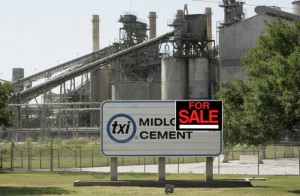 According to the Dallas Morning News, TXI Cement is up for sale with at least two possible buyers, Vulcan and Holcim, mentioned in last Friday's story. Along with kilns in California, the company's Midlothian and Hunter, Texas cement plants are on the block as part of the deal.
According to the Dallas Morning News, TXI Cement is up for sale with at least two possible buyers, Vulcan and Holcim, mentioned in last Friday's story. Along with kilns in California, the company's Midlothian and Hunter, Texas cement plants are on the block as part of the deal.
As the news reports note, the timing is a little strange in that the construction industry, the barometer for all things cement, is only now rebounding out of its Great Recession doldrums, and TXI's profits are nowhere near it's pre-collapse heights. It could be that the latest generation of the Rogers' family to run the firm isn't all that interested in keeping it running, or that the two largest and restless corporate shareholders, who now own 51% of the company, are anxious to deal.
Of the two suitors listed in the News article, Holcim is one of the industry's international giants that has the large cash reserves, while Vulcan is smaller, US-based, and considered more of an Aggregates business with some cement plants in Florida.
On the other hand, Holcim already operates a huge cement plant across the street from TXI in Midlothian. It's hard to imagine the company needing to double its manufacturing capacity in DFW. But perhaps TXI's California market share makes the deal look attractive as a whole and the Midlothian plant would be spun off to a third party. For Vulcan, it looks like a way to go from a regional powerhouse to a national one by buying plants in two large, influential state economies.
Holcim is a leader in the new waste-burning revival within the cement industry. Its Midlothian cement plant already has a permit to burn a long list of industrial wastes, although it's not as long as TXI's. During the economic downturn,TXI was given permission by Rick Perry's TCEQ (without public notice or participation) to burn a variety of new wastes like car "fluff" and plastics , but reportedly didn't have the capital to build the infrastructure needed to convey the wastes to the kilns. A new owner like Holcim might have the cash to fix that, and fixing that would mean lots more waste-burning. Buying TXI's Midlothian plant would mean buying its waste-burning permits as well, opening up new waste markets for Holcim without having to go to the trouble of a permitting process.
If Vulcan or some other middle-size player buys TXI, you can be sure they'll run the plants 24/7 as much as possible to recoup their investment and take advantage of better economic times. More production equals more air pollution, even with more modern controls forced by recent clean air plans and citizen campaigns.
But it's also possible to imagine a scenario where Holcim buys TXI, uses it's Midlothian limestone quarry to add to its own local reserves, but doesn't necessarily have the incentive to run both cement plants into the ground to justify the purchase price.
A sale of TXI by the Dallas-based Rogers family would be milestone in the industry, and in North Texas. TXI opened its first cement kiln in Midlothian in 1960. You can still see it there on Hwy 67, along with three other, older "wet" kilns that operated for 48 years before being shut down in 2008. They're all scheduled to be demolished later this year, leaving only the circa-2000 TXI Kiln #5 as a landmark. The times, they are a changin'. Stay tuned.
Dallas Council Passes 1500 Foot Setback and Rest of Draft Ordinance
 It was rumored to be a done deal as of last week. Today it actually is.
It was rumored to be a done deal as of last week. Today it actually is.
By a vote of 9 to 6, the Dallas City Council voted to endorse the new gas ordinance drafted by its City Plan Commission, including its 1500-foot setback requirement for wells and compressor stations.
The only change to the Commission recommendations came in a procedural tweak that now requires six votes to stop a variance being rolled back to a minimum of 1000 feet instead of four.
Oak Cliff Council Member Scott Griggs made the motion to approve the Plan Commission recommendations. Before his motion could be voted on however, East Dallas Council Member Sheffie Kadane made a substitute motion to reduce the required setback to 500 feet. This was the stark choice that faced the Council.
They chose wisely. 1500 feet matches the most protective buffer zone current restrictions in the Barnett Shale. It's more than twice as far as the 600 foot setback on the books in Fort Worth. Even the new Dallas minimum of 1000 feet is 400 more than Forth Worth's maximum. Much of todays' public hearing testimony touched on health effects felt by Shale residents who had lived from 300 to 1200 feet from wells.
Along with the defeat of the Trinity East permits earlier in the year, passage of the Dallas ordinance represents the biggest recent victories of urban fracking opponents in the Barnett Shale.
Not only is there a brand new "Dallas Model" to compete and contrast with the "Fort Worth Model" that industry loves to tout, but there's a brand new feeling that environmentalists actually have some clout in city politics in Dallas for the first time.
Congratulations to all those who worked so hard to see this result happen against so many obstacles over the last four years. Well done.

